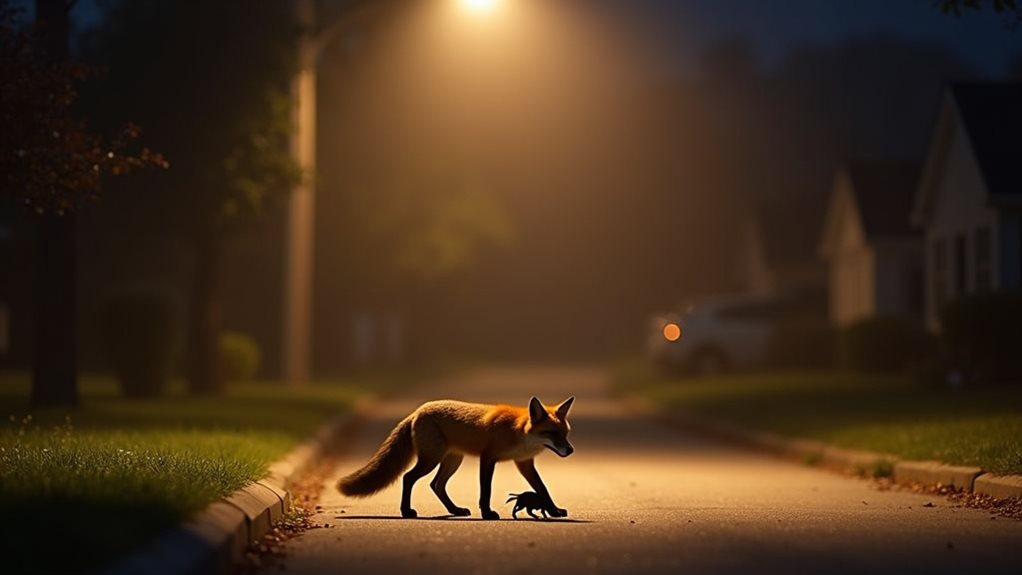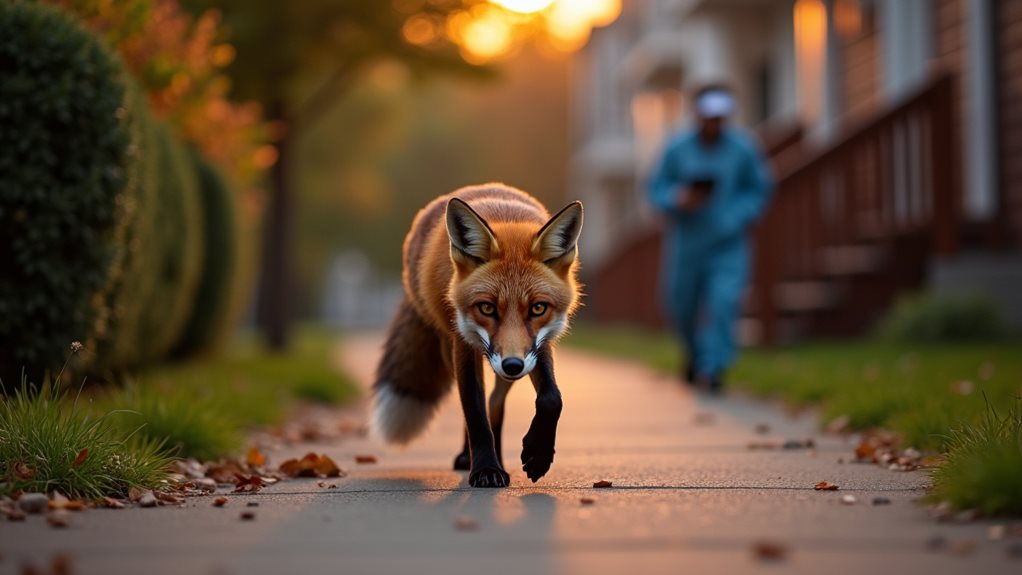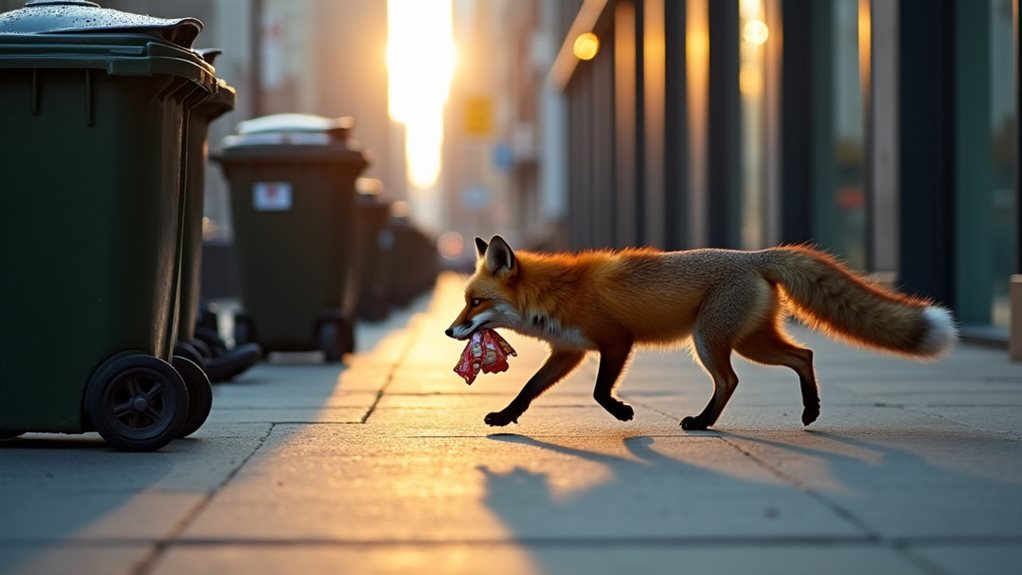Urban foxes aren’t the menacing creatures often portrayed in media. They maintain stable populations in territories of about 25 hectares per family, and they’re opportunistic eaters who prefer discarded food and small rodents over pets. You’ll face minimal health risks if you take basic precautions, and successful coexistence simply requires secure garbage bins and respecting their space. Explore the fascinating reality of these adaptable neighbors to discover how they’ve thrived alongside us for generations.
Contents
- 1 The Real Ecology of Urban Foxes: Population Dynamics and Territory
- 2 Diet and Feeding Behavior: What Urban Foxes Actually Eat
- 3 Health and Disease: Separating Science From Sensationalism
- 4 Human-Fox Interactions: Understanding Conflict and Coexistence
- 5 Conservation and Management: Evidence-Based Approaches for Urban Wildlife
- 6 Final Thoughts
The Real Ecology of Urban Foxes: Population Dynamics and Territory

While many urban dwellers believe their neighborhoods are overrun with foxes, the reality of urban fox populations might surprise you.
The average urban fox family maintains a territory size of about 25 hectares, much smaller than their rural cousins need. You’ll typically find just one family per territory, not the hordes you might imagine lurking in every alley.
Their breeding patterns follow a predictable annual cycle, with most cubs born in spring. A typical litter consists of 4-5 cubs, but don’t worry about a fox explosion—nearly 60% won’t survive their first year.
Natural mortality and territorial limitations keep populations in check. Contrary to popular belief, urban fox populations have remained relatively stable for decades, with territories passed down through generations.
They’re not invading; they’re your long-term neighbors with established zip codes! Urban foxes demonstrate remarkable adaptability to city life, showcasing their ability to thrive in diverse habitats.
Diet and Feeding Behavior: What Urban Foxes Actually Eat
Urban foxes are opportunistic eaters with impressive scavenging habits that help them thrive in our neighborhoods.
Here’s what urban foxes typically eat:
- Discarded human food from garbage bins and compost piles
- Small mammals like mice and voles that live in parks and gardens
- Insects, worms, and other invertebrates found in lawns and soil
- Seasonal fruits, berries, and plants that grow in urban areas
- Birds and their eggs, though they’re not as common in their diet as you might think
Contrary to popular belief, foxes rarely target pets and are more interested in your leftovers than your cat! Urban foxes also demonstrate dietary flexibility that enables them to adapt to the diverse food options available in city environments.
Health and Disease: Separating Science From Sensationalism

Despite what sensational headlines might’ve you believe, urban foxes aren’t the disease-ridden menaces they’re often portrayed as in the media.
Many urban myths circulate about foxes carrying dangerous diseases that threaten your family and pets, but the reality is far less alarming.
While foxes can carry certain parasites and illnesses (like any wild animal), the actual health risks to humans are minimal when basic precautions are taken.
You’re much more likely to catch something from another person on public transport than from a fox passing through your garden!
Simple steps like washing your hands after gardening, securing your trash bins, and keeping a respectful distance when you spot a fox will keep both you and these adaptable creatures safe and healthy.
In fact, healthy foxes typically avoid humans and pets, posing low health risks to the community.
Human-Fox Interactions: Understanding Conflict and Coexistence
The healthy boundaries discussed above form the cornerstone of successful human-fox interactions in urban environments.
When you understand both human behavior and fox behavior, coexistence becomes much easier.
Consider these key points for peaceful cohabitation:
- Don’t feed foxes directly—this changes their natural foraging patterns.
- Secure your garbage bins with wildlife-proof latches.
- Remove food sources like fallen fruit or pet food from your yard.
- If you spot a fox, make noise and appear large to maintain distance.
- Appreciate foxes from afar using binoculars or wildlife cameras.
You’ll find that most conflicts arise from misunderstandings about fox intentions.
They’re not plotting against your garden—they’re simply following their instincts! Their adaptability allows them to thrive in urban areas, enhancing your experience of living alongside wildlife.
With reasonable precautions, you can enjoy the wildlife spectacle these adaptable creatures provide.
Conservation and Management: Evidence-Based Approaches for Urban Wildlife

When scientists examine urban fox populations, they consistently find that evidence-based approaches yield the most successful conservation outcomes.
You’ll notice that cities with thoughtful urban planning that incorporates wildlife corridors and green spaces see healthier fox populations and fewer human-wildlife conflicts.
Habitat preservation isn’t just good for foxes—it benefits your entire community.
By maintaining patches of natural vegetation and limiting fragmentation, you’re creating a balanced ecosystem where foxes can thrive without becoming nuisances.
Some cities have implemented fox-friendly trash management systems that you might want to support in your neighborhood. Moreover, the presence of urban habitats contributes significantly to the adaptability of these foxes, ensuring their survival in changing environments.
Final Thoughts
You’ve just unmasked urban fox reality, congratulations! While your neighbors insist foxes are plotting world domination or raiding daycares, you’re now armed with actual science. Next time someone spins a tale about fox armies stealing babies, you’ll smile knowingly. These orange opportunists are just trying to survive in our concrete jungle—not unlike that neighbor who “borrows” your Wi-Fi. Let’s coexist with foxes using facts, not fiction.














